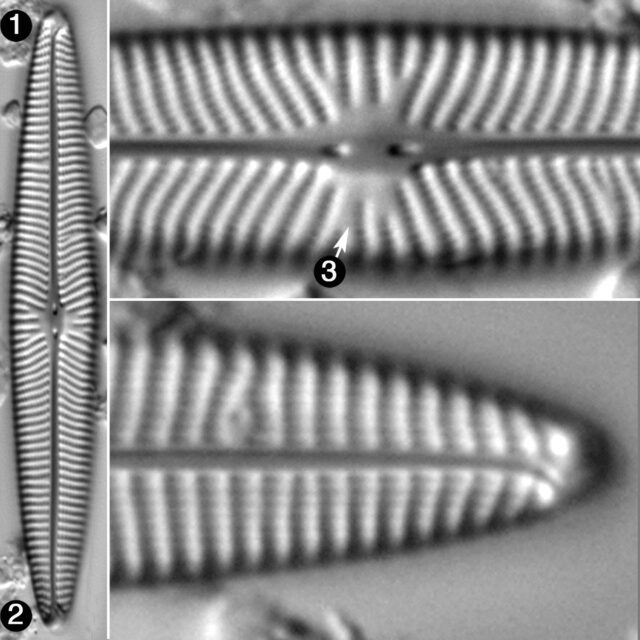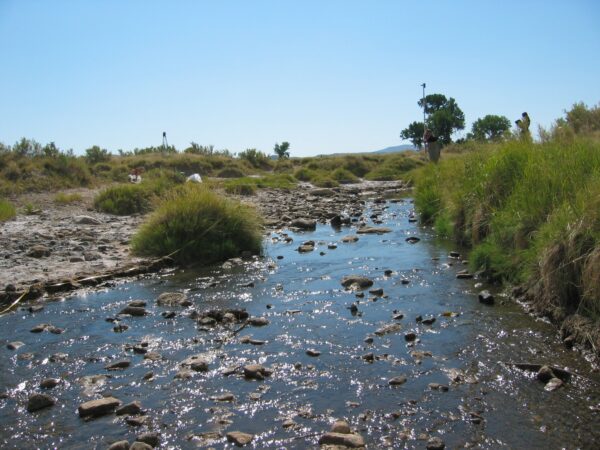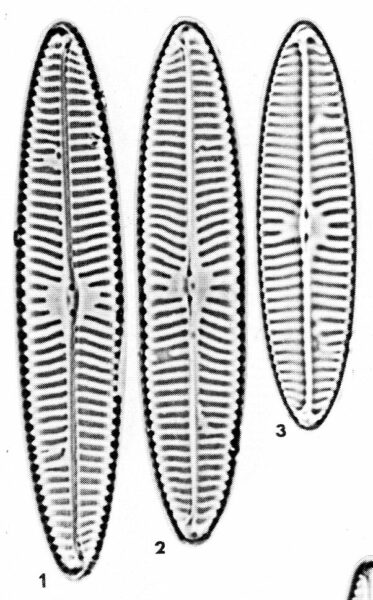Navicula margalithii
-
Category
-
Length Range35.0-68.0 µm
-
Width Range6.5-9.0 µm
-
Striae in 10 µm12-13
-
ContributorLoren Bahls - Jan 2016
-
ReviewerMarina Potapova - Jan 2016
Identification
Description
Valves are linear-lanceolate with wedge-shaped ends.The raphe is straight and filiform. The axial area is very narrow and linear. The central area is small and asymmetric. Proximal raphe ends are tear-shaped and straight. Striae are radiate and somewhat sinuous at the valve center, becoming parallel and straight, and then convergent near the apices. Central striae in larger specimens are sometimes alternately long and short. Areolae number about 32 in 10 µm.
This taxon is very similar to Navicula recens and differs mainly in valve size and salinity tolerance. It should not be ruled out that they are conspecific, with the larger size specimens that we call N. margalithii simply a morphological manifestation of the more electrolyte-rich waters in which they are found.
Autecology
This taxon prefers electrolyte-rich waters. The specimens on this page are from a stream in Wyoming that has a specific conductance of 18,100 µS/cm and a chloride content of 60 mg/L. Common diatom associates at this site include Haslea spicula, Mastogloia pumila, and Tryblionella compressa. Lange-Bertalot (2001) reports N. margalithii from saline, electrolyte-rich springs in the Negev Desert of Israel and Tunisia. In contrast, Navicula tripunctata and N. recens prefer fresh to brackish waters.
-
Size Range, µm3
-
Motility
-
Attachment
-
Habitat
-
Colony
-
BCG
-
Waterbody
-
Distribution
- Learn more about this
Citations & Links
Citations
Links
-
Index Nominum Algarum
-
North American Diatom Ecological DatabaseNADED ID: 46741
Cite This Page
Bahls, L. (2016). Navicula margalithii. In Diatoms of North America. Retrieved April 23, 2024, from https://diatoms.org/species/navicula_margalithii
Responses
The 15 response plots show an environmental variable (x axis) against the relative abundance (y axis) of Navicula margalithii from all the stream reaches where it was present. Note that the relative abundance scale is the same on each plot. Explanation of each environmental variable and units are as follows:
ELEVATION = stream reach elevation (meters)
STRAHLER = distribution plot of the Strahler Stream Order
SLOPE = stream reach gradient (degrees)
W1_HALL = an index that is a measure of streamside (riparian) human activity that ranges from 0 - 10, with a value of 0 indicating of minimal disturbance to a value of 10 indicating severe disturbance.
PHSTVL = pH measured in a sealed syringe sample (pH units)
log_COND = log concentration of specific conductivity (µS/cm)
log_PTL = log concentration of total phosphorus (µg/L)
log_NO3 = log concentration of nitrate (µeq/L)
log_DOC = log concentration of dissolved organic carbon (mg/L)
log_SIO2 = log concentration of silicon (mg/L)
log_NA = log concentration of sodium (µeq/L)
log_HCO3 = log concentration of the bicarbonate ion (µeq/L)
EMBED = percent of the stream substrate that is embedded by sand and fine sediment
log_TURBIDITY = log of turbidity, a measure of cloudiness of water, in nephelometric turbidity units (NTU).
DISTOT = an index of total human disturbance in the watershed that ranges from 1 - 100, with a value of 0 indicating of minimal disturbance to a value of 100 indicating severe disturbance.

Navicula margalithii
- Valves linear-lanceolate
- Valves large, 35-68 µm long
- Central area small and asymmetric
Valves are linear-lanceolate and large (35-68 µm long). The central area is small and asymmetric.
 Diatoms of North America
Diatoms of North America







